|
|
|
Sort Order |
|
|
|
Items / Page
|
|
|
|
|
|
|
| Srl | Item |
| 1 |
ID:
114186
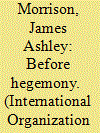

|
|
|
|
|
| Publication |
2012.
|
| Summary/Abstract |
While extensive scholarship has shown that it is possible to maintain global economic openness after hegemony, economic liberalization is still thought to be unlikely prior to hegemonic ascent. This assumption is based on the conventional narrative that Great Britain began lowering its trade barriers in the 1820s as it began its hegemonic ascent. This article shows that Britain began pursuing an open trading structure in the 1780s-in precisely the multipolar world that hegemonic stability theorists claimed would be least likely to initiate the shift. This change in commercial strategy depended crucially on the intellectual conversion of a key policymaker-the Earl of Shelburne-from mercantilist foreign economic policy to Adam Smith's revolutionary laissez-faire liberalism. Using the case of "the world's most important trading state" in the nineteenth century, this article highlights the importance of intellectuals-as well as their ideas-in shaping states' foreign policy strategies. It also provides further evidence of key individuals' significance and their decisions at "critical junctures."
|
|
|
|
|
|
|
|
|
|
|
|
|
|
|
|
| 2 |
ID:
133644
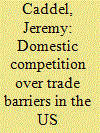

|
|
|
|
|
| Publication |
2014.
|
| Summary/Abstract |
As governments lower traditional tariffs, they may use non-tariff barriers, such as antidumping (AD) and countervailing duty (CVD) laws, to protect domestic industries. Research on the US International Trade Commission (ITC), an independent agency responsible for adjudicating AD/CVD claims, finds mixed evidence of political influence in these cases. However, this research focuses predominately on the political influence of the petitioning industry. Applying theories of bureaucratic oversight, I posit that the ITC must be receptive both to petitioners and to firms that oppose trade barriers. Using an original data set compiled from ITC records of witness testimony in these cases, I demonstrate that domestic opposition to an AD/CVD petition has a significant effect on ITC decisions. Moreover, members of Congress actively intervene on both sides of AD/CVD petitions and have some influence on ITC decisions. These results suggest that AD/CVD politics in the United States is better understood as a contest between competing domestic interests than a captured bureaucracy providing rents to protectionist interests.
|
|
|
|
|
|
|
|
|
|
|
|
|
|
|
|
| 3 |
ID:
120215
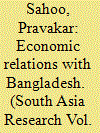

|
|
|
|
|
| Publication |
2013.
|
| Summary/Abstract |
Since 1971, India was the major trading partner of Bangladesh. However, China's trade with Bangladesh has increased manifold in recent years to surpass India from 2004 onwards. This slowing down and change of economic relations between India and Bangladesh, coupled with strained and uncertain political relations, raise multiple concerns. This article examines the various factors that have contributed to China's growing presence in Bangladesh as compared to India's decline with respect to trade and investment. India has clearly lost out to China in many important industries. While reviewing and assessing recent developments, the study also presents a strategy to counter India's declining economic influence in Bangladesh.
|
|
|
|
|
|
|
|
|
|
|
|
|
|
|
|
| 4 |
ID:
131503
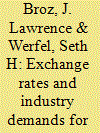

|
|
|
|
|
| Publication |
2014.
|
| Summary/Abstract |
The recent confrontation between China and the United States over currency policy illustrates a broader phenomenon: exchange-rate misalignments tend to spill over into trade policy. Although previous studies have shown that aggregate protectionist activity is positively related to the level of the real effective exchange rate, we explore this relationship at the industry level. Several industry-specific characteristics determine the protectionist response to exchange rate changes, including the degree of exchange-rate pass-through, the level of import penetration, and the share of imported intermediate inputs in total industry inputs. We find that the marginal effect of currency appreciation on the number of industry-level antidumping petitions is positive and significant only for industries with high pass-through. Therefore, exchange rates appear to induce demands for trade barriers only in industries where competitiveness is directly harmed by currency appreciation.
|
|
|
|
|
|
|
|
|
|
|
|
|
|
|
|
| 5 |
ID:
145564
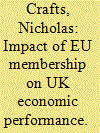

|
|
|
|
|
| Summary/Abstract |
The relatively deep level of economic integration achieved by the European Union (EU) has been highly successful in increasing trade for its members. Larger trade volumes have had positive effects on productivity levels. In the case of the United Kingdom the gain from joining the EU was probably around 10 per cent of GDP and this far exceeded any costs of membership, possibly by a ratio of seven to one. A major reason for this outcome was a significant increase in competition as protectionism was abandoned. The economic implications of Brexit are much less clear because there are many permutations of what it would entail. Future trade barriers rather than budgetary transfers are the main issue. Brexit could be quite costly if the UK left the single market and used its new policy space badly. Ironically, while Brexit clearly appeals to free traders, it could end up empowering protectionists.
|
|
|
|
|
|
|
|
|
|
|
|
|
|
|
|
| 6 |
ID:
117635
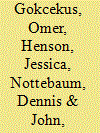

|
|
|
|
|
| Publication |
2012.
|
| Summary/Abstract |
Cyprus is a divided island. Despite the lack of a comprehensive peace agreement reunifying the country, in 2004 trade commenced across the Green Line that separates the Greek and Turkish Cypriot communities. The volume of trade has grown steadily since, but has it reached its full potential? First, a gravity equation is estimated by using an 'out-of-sample' estimation strategy to predict potential trade for the period from 2004 to 2009. We observe a sizable gap between potential and actual volumes of trade. We then attempt to account for this gap by analyzing economic, legal, and social-psychological barriers that can explain this difference. It is found that (1) actual trade has only reached around 10% of its potential, with (2) legal constraints accounting for 35% of the missing trade, (3) extra transportation costs for about 5%, and (4) unmeasurable and social-psychological barriers for a significant amount of between 48% and 60%, depending on the year. The findings suggest that attention must be paid to the objective barriers to trade as well as the subjective interpersonal and intercommunal perceptions that can affect trade and ultimately, peaceful resolution of the conflict. These findings have implications for other conflicts in which divided communities with the potential for trading across a shared border seek to maximize the joint economic and political gains of emerging interdependence.
|
|
|
|
|
|
|
|
|
|
|
|
|
|
|
|
| 7 |
ID:
108609
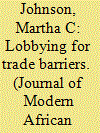

|
|
|
|
|
| Publication |
2011.
|
| Summary/Abstract |
Over the last two decades, developing countries have lowered trade barriers considerably. As a result, they have experienced a surge in food commodity imports. In Ghana, Senegal and Cameroon, a flood of frozen poultry imports in the late 1990s and early 2000s threatened domestic poultry producers. In response, they organised to demand protectionist measures. This article examines why the Cameroonian and Senegalese governments responded to these demands while the Ghanaian government did not. Employing data from interviews in Senegal, newspaper coverage in all three countries, and documentation from non-governmental organisations, it argues that Cameroonian, and to a lesser extent Senegalese, producers were able to influence government policy because they faced few barriers to collective action and built alliances with consumers before lobbying government. The findings suggest that a public choice, interest group-focused approach is still useful for explaining policy outcomes in West Africa.
|
|
|
|
|
|
|
|
|
|
|
|
|
|
|
|
| 8 |
ID:
105736
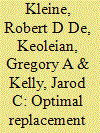

|
|
|
|
|
| Publication |
2011.
|
| Summary/Abstract |
The use of ethanol as a fuel has been attracting increasing attention in countries that are interested in reducing their dependence on imported oil and lowering their greenhouse gas emissions. Despite this growing interest, the global ethanol market is still incipient because of the small number of producing countries, the lack of technical standardization and the existence of tariff and non-tariff trade barriers. New laws have taken effect in 2010 in the United States and the European Union imposing domestic requirements for sustainable production of ethanol. Although these are generally positive developments, they can create greater difficulties for the development of an international ethanol market. This work examines the technical barriers posed by these new laws and how they can be resolved under the auspices of the World Trade Organization. In addition, this work analyses the Brazilian and Caribbean cases discussing to what extent these new technical barriers will affect ethanol production and exports arising from these countries.
|
|
|
|
|
|
|
|
|
|
|
|
|
|
|
|
| 9 |
ID:
086414
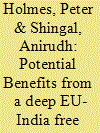

|
|
|
|
|
| Publication |
2009.
|
| Summary/Abstract |
Both parties to an eventual EU India FTA have agreed that it should not merely address tariff barriers but should also go further into what is known as deep integration, originally developed in the 1990s by R.Z. Lawrence. This relates to the removal of all obstacles to cross border business whether actual trade barriers or domestic regulations. We distinguish deep institutional integration from the deep integration of markets. We ask the question how one may support the other. There are potential market failures that can be addressed by trans-national rules on standards and technical regulations and services, but we conclude that the biggest impact of a deep RTA would be on the domestic economy of India if it provides an opportunity for reform. It should be noted that the paper draws on a study undertaken by the authors for DG Trade, but it represents only the views of the authors.
|
|
|
|
|
|
|
|
|
|
|
|
|
|
|
|
| 10 |
ID:
048291
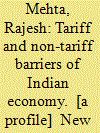

|
|
|
|
|
| Publication |
New Delhi, Research and Information System for the Non-Aligned and Other Developing Countries, 1999.
|
| Description |
97p.
|
| Standard Number |
8171220738
|
|
|
|
|
|
|
|
|
|
|
|
Copies: C:1/I:0,R:0,Q:0
Circulation
| Accession# | Call# | Current Location | Status | Policy | Location |
| 042716 | 382.70954/MEH 042716 | Main | On Shelf | General | |
|
|
|
|
|
|
|
|
|